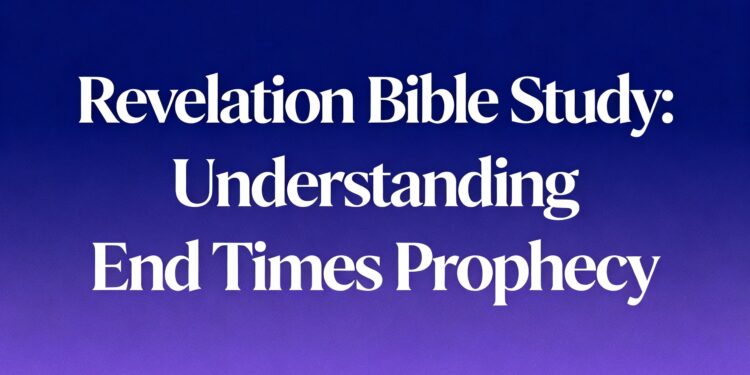No products in the cart.
Revelation Bible Study: Understanding End Times Prophecy
This post contains paid and/or affiliate links. I make a small commission at no extra cost to you. Please see our Privacy Policy.
Studying the book of Revelation and exploring end-times prophecy stands as one of the most demanding yet enriching endeavors in biblical scholarship.
Its striking imagery and layered symbolism have intrigued both theologians and everyday readers for generations.
This guide presents effective strategies for interpreting prophetic literature and offers practical techniques for retaining biblical knowledge through proven memorization methods.
The Foundation of Biblical Eschatology
Establishing Context for End-Times Study
A proper understanding of Revelation begins with a strong grounding in biblical eschatology. End-times prophecy involves far more than curiosity about future events—it reflects a theological framework woven throughout both the Old and New Testaments.
Prophetic books such as Daniel, Ezekiel, and Zechariah supply essential background for interpreting Revelation’s symbolic language.
Scholars consistently warn that studying biblical prophecy without sound interpretive principles leads to misunderstanding. As an apocalyptic text, Revelation follows literary conventions distinct from narrative or epistles, and recognizing these differences is vital for accurate interpretation.

The Structure of Revelation
Revelation follows an intentional design that supports meaningful study. Chapters 1–3 address the seven churches of Asia Minor, grounding the book in its historical moment.
Chapters 4–5 reveal the heavenly throne room and introduce the Lamb who alone can open the sealed scroll. The remaining chapters unfold in escalating cycles of judgment—seals, trumpets, and bowls.
This pattern reflects theological purpose more than strict chronology. The recurring visions suggest thematic repetition, not a linear sequence. Recognizing this structure prevents confusion when similar events appear multiple times throughout the text.
Major Interpretive Approaches
The Four Primary Schools of Thought
Christian interpretation of Revelation generally falls into four main frameworks:
- Preterist: Most prophecies were fulfilled in the first century, especially through Roman persecution and Jerusalem’s fall in 70 AD.
- Historicist: Revelation outlines the entire span of church history, with its symbols corresponding to major historical events.
- Futurist: Chapters 4–22 describe events still to come, leading up to and surrounding Christ’s return; this view dominates modern evangelical thought.
- Idealist: Revelation conveys timeless spiritual truths rather than specific historical or future events, focusing on the ongoing battle between good and evil.
Evaluating These Approaches
Each perspective offers strengths and limitations. Preterism stresses original context but may reduce future relevance. Historicism provides continuity but can rely on subjective correlations.
Futurism emphasizes prophetic fulfillment yet may overlook first-century significance. Idealism highlights enduring truths but risks detaching the text from concrete prophecy.
A balanced approach acknowledges the value of multiple perspectives while maintaining consistency in interpretation.
Key Themes in Revelation
The Sovereignty of God
Central to Revelation is the affirmation that God reigns over history and the universe. Though chaos and evil often appear dominant, Revelation repeatedly displays God’s control. The throne room visions emphasize God’s eternal authority and offer comfort to believers facing trials.
Christ’s Ultimate Victory
The slain Lamb stands at the heart of Revelation’s message. This paradox—sacrifice united with triumph—shows that Christ conquers through faithful suffering and resurrection power. The closing chapters portray His final victory over all evil and the renewal of creation, grounding Christian hope in His coming kingdom.
The Call to Faithful Witness
Revelation calls readers to active obedience. The messages to the seven churches include encouragement, rebuke, and a call to perseverance. True study of eschatology shapes character and conduct, not merely intellectual understanding.
Symbolic Language and Imagery
Numerical Symbolism
Numbers in Revelation carry symbolic significance: seven for completeness, twelve for God’s people, and three-and-a-half for limited tribulation. The number 666—humanity’s number—symbolizes imperfection and inadequacy apart from God. Recognizing symbolic patterns deepens comprehension.
Cosmic Imagery
Revelation’s dramatic symbols—beasts, dragons, heavenly signs—draw heavily from earlier prophetic writings. Proper interpretation requires familiarity with these Old Testament sources. Avoiding excessively literal readings helps guard against distorted or sensational views.

Practical Application for Today’s Students
Approaching Revelation Responsibly
Responsible study requires humility and caution. Many failed predictions throughout history warn against forcing current events into the text.
Essential principles include:
- Prioritize clear passages over ambiguous ones
- Recognize symbolic language
- Focus on theology rather than speculative timelines
- Consult interpretations across historical and theological traditions
- Apply insights to present faithfulness, not future calculations
Integrating Study with Practical Faith
Revelation should strengthen, not distract from, Christian discipleship. When prophecy study leads to fear, division, or preoccupation with world events, it has strayed from its biblical purpose. Proper study inspires worship, service, evangelism, and spiritual maturity.
Common Pitfalls
Overconfidence in predictions has repeatedly led to error. Date-setting and identifying modern figures as the Antichrist consistently fail and undermine credibility.
Ignoring historical context leads to anachronistic readings. Understanding the world of first-century believers—Roman persecution, apocalyptic traditions, and early church circumstances—provides crucial clarity.
Conclusion
A thoughtful study of Revelation yields profound insight but requires humility, careful method, and a focus on what the text intends to accomplish.
End-times prophecy is best understood through a blend of scholarly rigor, spiritual discernment, historical awareness, and practical obedience.
Ultimately, Revelation points to Christ’s final victory, God’s sovereign rule, and the believer’s call to steadfast faith until His return brings the fulfillment of all things.















